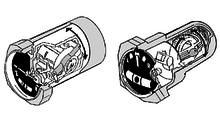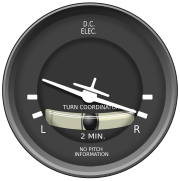Turn indicator
A turn indicator is an electrically driven gyroscope . It is used to display the direction and speed of rotation of the aircraft around the vertical axis . The turning pointer was initially the central instrument in equipment for instrument flight . In gliding it is also operated pneumatically (by the airstream ).
There are two types of turn indicators : the original turn indicator and the later developed turn coordinator . In German, both instruments are referred to as "turning pointers", which can lead to misunderstandings. The term " curve coordinator " was not able to establish itself in the German-speaking area.
Usually a second instrument, the bubble level , is built into the index pointer. This shows the quality of the curve coordination. This combination led to the name turn and bank indicator , often abbreviated to “T&B”. Although this term is common, it is actually wrong, if at all it should be turn and slip indicator .
In contrast to the artificial horizon , the turning pointer does not show the position in space , but the speed of rotation of the aircraft around the vertical or vertical and longitudinal axes. The position in space must be deduced from the interaction of this display with the displays of other flight instruments, which is quite abstract. Nevertheless, for safety reasons, the turning pointer is an indispensable instrument for flying blind , as, unlike the artificial horizon, it can neither stagger nor wander, but always points correctly.
Turn indicators are also used on ships.
Turn indicator
construction
The turn indicator is based on a semi-gimbal suspended top that has only two degrees of freedom - see tied top . (One of these degrees of freedom is the rotation around the top axis. However, by definition, this is always present in a top. Therefore, it is not counted in the Anglo-Saxon area, for example.
The gyro axis is mounted parallel to the aircraft transverse axis. The two devices differ in that with the turn indicator, the movable frame, in which the gyro is suspended, is mounted so that the axis of rotation of the frame is parallel to the longitudinal axis of the aircraft, whereas with the turn coordinator the axis of rotation of the frame is tilted 30 ° to the longitudinal axis of the aircraft is. This means that the turn indicator only shows rotations around the vertical axis of the aircraft (yaw), while the turn coordinator shows rotations around both the vertical and longitudinal axis (roll).
functionality
When the aircraft flies in a curve and the aircraft turns around its vertical axis, the axis of rotation of the gyro tilts due to the precession . This tilting movement, which depends on the cornering speed, is indicated by a pointer.
Depending on the rate of precession of the gyroscope, the aircraft symbol of the turn coordinator tilts to the left or right. The faster the angular velocity, the greater the top precession and the bank of the airplane symbol.
If the artificial horizon fails, at least one of the two axes can be replaced with the turn indicator. In combination with the altimeter , the airspeed indicator, possibly the rev display and the variometer , important information about the flight position can still be derived.
use
In powered aircraft today, the turn indicator is mostly found in the form of a curve coordinator. Since in powered flight, long straight flight flights are usually only interrupted by short curves to correct course, the turn indicator is used here primarily to maintain straight flight. The curve coordinator fulfills this purpose best, since each curve is first initiated by a roll. The curve coordinator reacts much more sensitively to the beginning of a curve than the classic turn indicator.
For gliders, however, the curve coordinator with its "mixed display" of two different axes of rotation is unsuitable for various reasons. Here you can only find the classic turn indicator.
Spherical vial

construction
The dragonfly, also known as an “inclinometer”, is a curved glass tube filled with liquid in which a steel ball can move back and forth. The ball in the level shows the direction of the plumb line , ie the vector sum of centrifugal force and gravity .
functionality
The level can be used to assess how cleanly a curve is flown, i.e. H. how well the turn is "coordinated". The ball in the vial stops between the two vertical auxiliary lines when the forces occurring in curves are just balancing and the aircraft is thus flying a coordinated curve. The ball is, however, outside of the two marks, the aircraft either a power- shift curve (engl. Skid ) ( bank too low; ball outwardly moved) or a lubricating curve (engl. Slip ) ( bank too large; ball migrates to the inside of the curve).
When the tip of the plane symbol touches the marking on the right or left, you fly at a turning speed of 3 degrees per second, 180 ° ("turn") in 1 minute. or 360 ° in 2 min. This is called a standard rate of turn . The plane flies a full circle in two minutes. The bubble level should always be exactly in the middle, otherwise the aircraft will push (outward) or smear (inward).
Interaction of both sub-instruments
It makes sense that these two instruments have been combined. Both together say something about cornering behavior. As can be seen from the adjacent graphics, with the same curve speed around the longitudinal axis (airplane symbol inclined to the right) either a coordinated curve or a slip (dragonfly ball on the right in this example) or skid (dragonfly ball on the left in this example) can be flown. This leads eventually to a non-observance spiral dive (Engl. Spiral ).
In order to avoid such uncoordinated turns, the pilot must “step into the ball” when the ball deviates from the center, ie step into the rudder that corresponds to the position of the ball.
Possible dangers
As described above, the curve coordinator has a gyro mounted at an angle of 30 °. This means that the device will display both roll and yaw. If the aircraft is rolling, the display of the added curve coordinator the roll rate by a certain factor for the yaw rate. Only when the aircraft has finished taxiing does the device only display the yaw rate again.
Pilots who are not familiar with this principle could have difficulties using the curve coordinator , for example seeing a display when rolling, but interpreting it as a turn display.
Older, purely mechanical barometric variometers work without auxiliary energy, but the turn indicator function required electrical drive power for the rotary motor (for example 36 V / 400 Hz three-phase current). If the power supply fails, the gyro will continue to rotate for a few minutes until the angular speed can no longer be displayed.
The spherical vial works via the centrifugal force that occurs when turning and therefore does not need any auxiliary energy.
literature
- Götsch, Ernst: Luftfahrzeugtechnik , Motorbuchverlag, Stuttgart 2003, ISBN 3-613-02006-8
- Rod Machados's Private Pilot Handbook . Chapter 2, “Aerodynamics - The wing is the thing”. 2001
- Rod Machados's Instrument Pilot's Survival Manual . 1998, ISBN 0-9631229-0-8
- Peter Dogan: Instrument Flight Training Manual . 1999, ISBN 0-916413-26-8
- Jeppesen Sanderson: Private Pilot Manual . 2001, ISBN 0-88487-238-6





